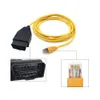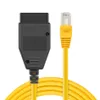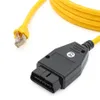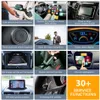ENET cables are a popular tool for BMW owners who want to diagnose and fix issues with their vehicles. These cables allow for fast data transfer rates, accurate results, and no need for expensive diagnostic software. They are compatible with F-Series BMWs and are easy to use. To get started, simply connect the cable to your computer and car, download the necessary software, and follow the step-by-step instructions. The benefits of using an ENET cable over traditional diagnostic methods include increased accuracy, faster data transfer, and cost-effectiveness. Real-life examples of how the ENET cable has helped BMW owners diagnose and fix issues with their cars will be highlighted. If you’re a BMW owner looking to save money on diagnostic services while maintaining your vehicle’s performance, an ENET cable may be just what you need.








ENET Cable Overview
If you’re a BMW owner and want to get the most out of your vehicle, an ENET cable is an essential tool that you should consider adding to your toolbox. In this article, we’ll delve into what an ENET cable is, how it works, and its compatibility with F-Series BMWs.
What is an ENET Cable?
An ENET cable is a diagnostic tool used to connect your BMW’s onboard computer system (OBD) to a compatible device, such as a laptop or smartphone. It enables you to access and modify various settings on your vehicle, including engine management, airbags, and other electronic control units (ECUs).
How Does it Work?
The ENET cable works by connecting your BMW’s OBD port to your laptop or smartphone via an Ethernet cable. This allows you to access the BMW Standard Tools software, which is used for advanced diagnostics and coding.
ENET cables use Ethernet protocols to transfer data between your vehicle and your device. This means that they can offer faster data transfer rates than other types of cables, such as USB or RS-232.
Compatibility with F-Series BMWs
ENET cables are compatible with all F-Series BMW models, including the 1 Series, 2 Series, 3 Series, 4 Series, 5 Series, 6 Series, 7 Series, X1, X3, X4, X5, and X6. They can also be used on some E-Series vehicles, but compatibility may vary depending on the model year and specific features.
Features of ENET Cables
Some of the key features of ENET cables include:
Fast Data Transfer Rates – ENET cables use Ethernet protocols to transfer data between your vehicle and your device, offering faster transfer speeds than other types of cables.
Accurate Results – ENET cables provide accurate diagnostic results, allowing you to pinpoint issues with your vehicle’s engine management or other systems quickly.
Ease of Use – ENET cables are easy to use, and there are many resources available online to help you get started with using them.
How to Use the ENET Cable
Step 1: Purchase an ENET Cable
The first step in using the ENET cable is to purchase one. There are many different cables available, but we recommend purchasing one from a reputable source. You can find ENET cables online or at your local auto parts store.
Step 2: Download the Software
Once you have your ENET cable, the next step is to download the software. The software is what allows you to connect to your BMW’s diagnostic system. There are many different software options available, but we recommend using BimmerGeeks Pro Tool. This software is easy to use and provides detailed information about your BMW.
Step 3: Connect the ENET Cable
Now that you have the software downloaded, it’s time to connect the ENET cable to your BMW. To do this, locate the OBD-II port on your BMW. This port is usually located under the dashboard on the driver’s side of the vehicle. Once you have located the port, plug the ENET cable into it.
Step 4: Connect to the Software
After connecting the ENET cable to your BMW, it’s time to connect to the software. Open the BimmerGeeks Pro Tool software on your computer. Click the “Connect” button in the top right corner of the screen. The software should automatically detect your BMW and connect to it.
Step 5: Diagnose Issues
Now that you are connected to the software, it’s time to diagnose any issues with your BMW. The software will provide you with detailed information about your BMW’s diagnostic system. This includes information about any error codes that may be present, as well as recommendations for fixing any issues.
Benefits of Using an ENET Cable
When it comes to diagnosing issues with your BMW, traditional methods can be time-consuming and sometimes inaccurate. This is where an ENET cable comes in handy. Using an ENET cable has several benefits over traditional diagnostic methods, including increased accuracy, faster data transfer, and cost-effectiveness.
The first advantage of using an ENET cable is accuracy. Diagnostic codes are incredibly precise, and any small deviation can lead to incorrect diagnosis. An ENET cable provides a direct connection between your BMW’s diagnostic system and your computer, ensuring that the information you receive is accurate and reliable.
The second advantage of using an ENET cable is faster data transfer. Traditional diagnostic methods require you to manually input codes, which can take hours. With an ENET cable, however, the data is transferred directly from your BMW’s diagnostic system to your computer, saving you valuable time.
Finally, an ENET cable is cost-effective. Traditional diagnostic methods require specialized equipment that can be expensive to purchase and maintain. An ENET cable, on the other hand, is relatively inexpensive and only requires a computer to operate.
One real-life example of how an ENET cable has helped BMW owners is by providing them with access to advanced diagnostics and coding software. This software allows owners to diagnose and fix issues with their vehicles themselves, without having to take their cars to a mechanic. This not only saves time but also money.
Another example is the ability to program specific settings for their BMWs, such as turning off seatbelt chimes or adjusting the volume of their navigation system. These settings may seem minor, but they can greatly improve the driving experience for many BMW owners.
In conclusion, using an ENET cable has numerous benefits over traditional diagnostic methods. Not only does it provide increased accuracy and faster data transfer, but it is also cost-effective. Real-life examples of how the ENET cable has helped BMW owners diagnose and fix issues with their vehicles showcase just how valuable this technology is. So, if you are a BMW owner, consider investing in an ENET cable today to save yourself both time and money.
FAQ
Q1. What is an ENET cable and how does it work with BMW diagnostics for F-Series vehicles?
The ENET cable is a specialized tool designed to facilitate fast and accurate data transfer between a BMW F-Series vehicle and a diagnostic device. It connects directly to the OBD-II port in the vehicle and allows for seamless communication with the vehicle’s onboard computer systems. This enables technicians and enthusiasts to access a wide range of diagnostic information, including fault codes, live sensor data, and performance metrics.
Q2. What are the benefits of using an ENET cable for BMW diagnostics?
Using an ENET cable for BMW diagnostics offers several key advantages. Firstly, it provides a faster and more reliable connection than traditional diagnostic tools, allowing for real-time data transfer and analysis. Additionally, the ENET cable is compatible with a wide range of diagnostic software, making it a versatile and cost-effective solution for professional technicians and DIY enthusiasts alike. Finally, the ENET cable allows for advanced coding and programming capabilities, giving users the ability to customize and optimize their vehicle’s performance and functionality.
Q3. Is the ENET cable easy to use for non-professionals?
While the ENET cable is a powerful diagnostic tool, it is also designed to be user-friendly and accessible to non-professionals. The cable itself is simple to connect to the OBD-II port in the vehicle, and the accompanying diagnostic software typically features intuitive user interfaces and clear instructions. However, it’s important to note that while the ENET cable can provide valuable diagnostic information, interpreting and acting on that information may require some level of technical expertise or experience.
Q4. Are there any potential drawbacks to using an ENET cable for BMW diagnostics?
One potential drawback of using an ENET cable for BMW diagnostics is the risk of causing damage to the vehicle’s onboard computer systems if not used carefully and responsibly. Additionally, while the ENET cable itself is relatively affordable, some diagnostic software options may come with additional costs. Finally, it’s worth noting that using the ENET cable for advanced coding and programming functions may void the vehicle’s warranty or violate local regulations, so users should proceed with caution and ensure they are operating within legal and ethical boundaries.